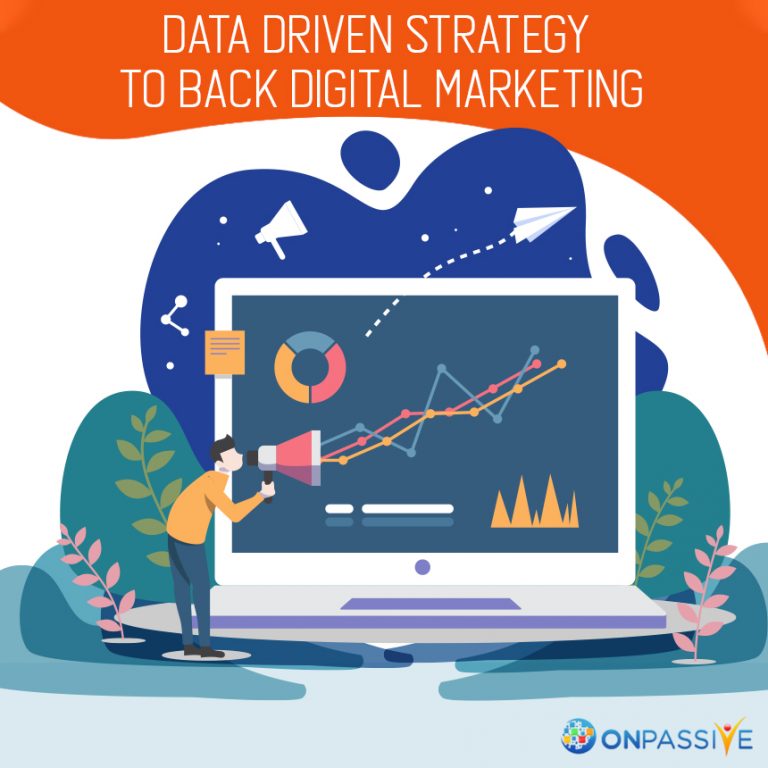
You have to be aware of what your consumers want in this digital day or age! At present, there is an array of tools that empower marketers to capture a wide range of data at specific stages in their digital marketing campaigns. Gone are those days of bulk, untargeted broadcasting. The era of digital marketing has brought widened reach- but pinpoint targeting precision.
To make sure that your digital marketing department is adequately contributing to your business, you must have an actionable, data-driven strategy. Data can point out the exact strengths and weaknesses of every part of your organization, enabling you to make strategic decisions that serve your digital marketing efforts to become more successful. Nearly 87% of marketers believe that data is their company’s most underused asset.
So why do you need to implement a data-driven strategy into your business and start reaping the benefits? Let’s find out!
What is a Data-driven Strategy?
A data-driven strategy is a set of methods and tactics that leverages vast amounts of data to create efficient digital marketing processes, targeting particular user groups and demographics at an individual level. This data can provide better insights into customer behavior, and taking advantage of it can be of utmost importance to your business.
Here are the 5 top tips for you to make sure you’re utilizing the data-driven strategy to drive your digital marketing strategy efficiently.
Build Your Team
Before you start interpreting data, it’s essential to assemble a team to manage that data. This team must include members from various departments and cross-disciplinary teams. It signifies that you have to look for individuals ready to go beyond their fields of expertise. For instance, Data scientists have to be prepared to learn about the emerging skillset named digital marketing. Salespeople may need to learn about the IT skill. Prioritize the collaboration between these separate individuals by scheduling frequent, concentrated meetings in which everyone shares their ideas and information and can take credit as a successful team.
Determine Your Goals
There’s one more step before you begin gathering data: being aware of what data is worth accumulating. Decide what types of data can have a positive influence on your digital marketing strategy. Leave data that won’t be utilized to enhance the effectiveness of your strategy, and concentrate on collecting data around critical KPIs that can genuinely move the needle.
Collect Your Data
Once you’re equipped to start accumulating your data, you’ll then want to make sure that you put it in one place for a more straightforward analysis. Consider acquiring the following types of data:
- Target audience
- Competitors
- Social media & digital marketing analytics (impressions, click-throughs, conversions, etc.)
- Consumer data (including transactional data, persona, social network activity, online activity)
- Prospect data
- Qualitative data
A person can get started by inquiring about your new team’s various members on what types of data they generate and consume. Data sometimes hide within your business’s inner resources—possibly with resellers or dealers or of your product or service, or locked up in an IT vault.
Once the data have been interpreted, you can learn from what’s happening at every stage of the consumer lifecycle, including information such as concerns at the point of sale, complaints or service calls, referrals, online recommendations, and back-to-back purchases.
Evaluate Your Data and Take Action Accordingly
Assess your data against your KPIs; you can begin utilizing that data-driven strategy to drive your digital marketing success:
- Refine Your Content Marketing Strategy: You may already employ content marketing to attract and engage your audience. But you might not have a clear strategy behind your content! When you have the data to make the right decisions, however, you’re well on your way to success. You can even blend your sales and content market strategies effortlessly to earn more revenue.
- Consider a New Submarket: With all of these data insights you have, you must decide to create a fresh submarket for your products or services. It doesn’t indicate that you have to change your brand entirely; possibly, you wish to modify who you’re selling to. The overall objective is to look for new niches and serve new audiences with your excellent products/services.
- Remove Hurdles: Your data can help you find out the obstacles your potential buyers face during the sales process. Now, you must decide how to address those concerns.
- Explore Alternative Digital Marketing Channels: Have you discovered that your company isn’t reaching its relevant audience? If your website is the solitary channel you use to share your products or services, your company isn’t likely to be sustainable. Your data-driven strategy will encourage you to look into other channels and formats.
Keep Experimenting with New Things
While your data-driven strategy can help develop new digital marketing strategies, it must be continuously managed and tested. The testing of your digital marketing efforts with small experiments can be performed in a day. The goal is to be capable to promptly and efficiently collect valuable data so that you can continue to draw conclusions and develop new experiments.
Wrapping Up
From this brief overview, it is apparent that those who intend to develop a digital marketing strategy cannot neglect such data. The development opportunities are endless. It depends on the goals that are to be reached. Each tip guides us in our decision for the most relevant actions: this is the data-driven strategy. Just an excellent idea is not enough to create a successful business.


